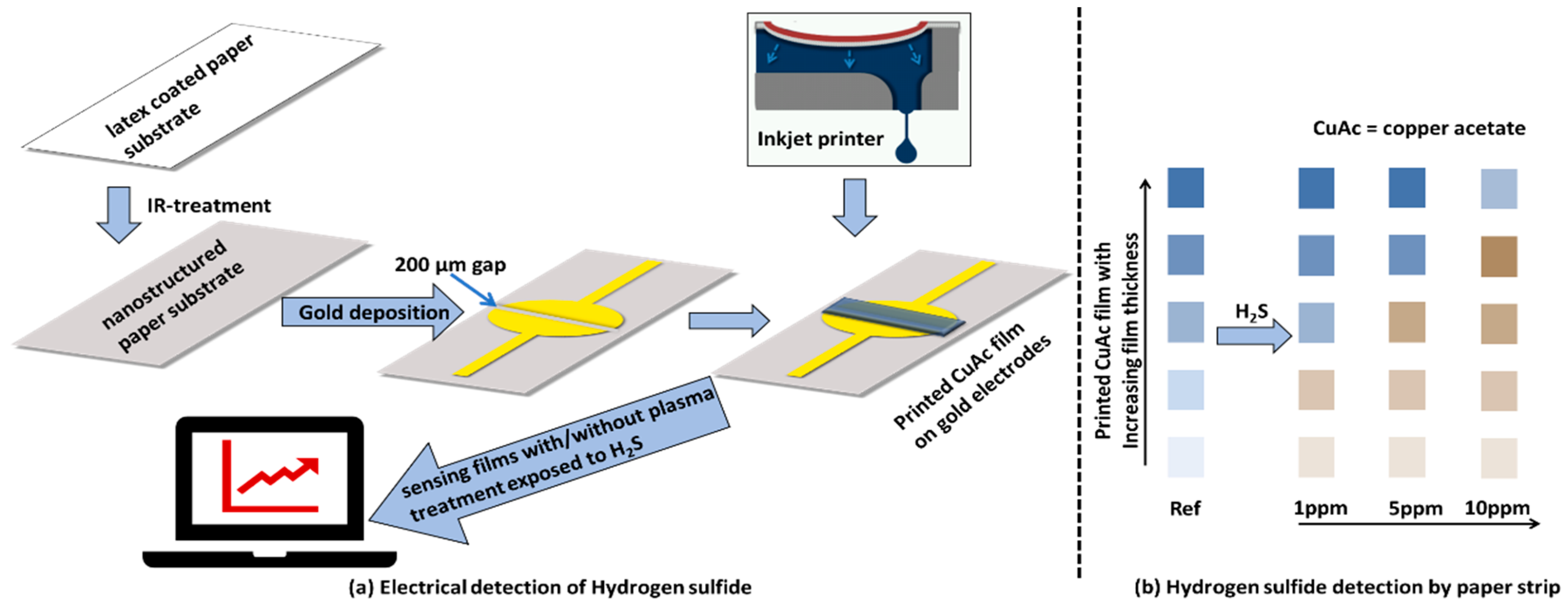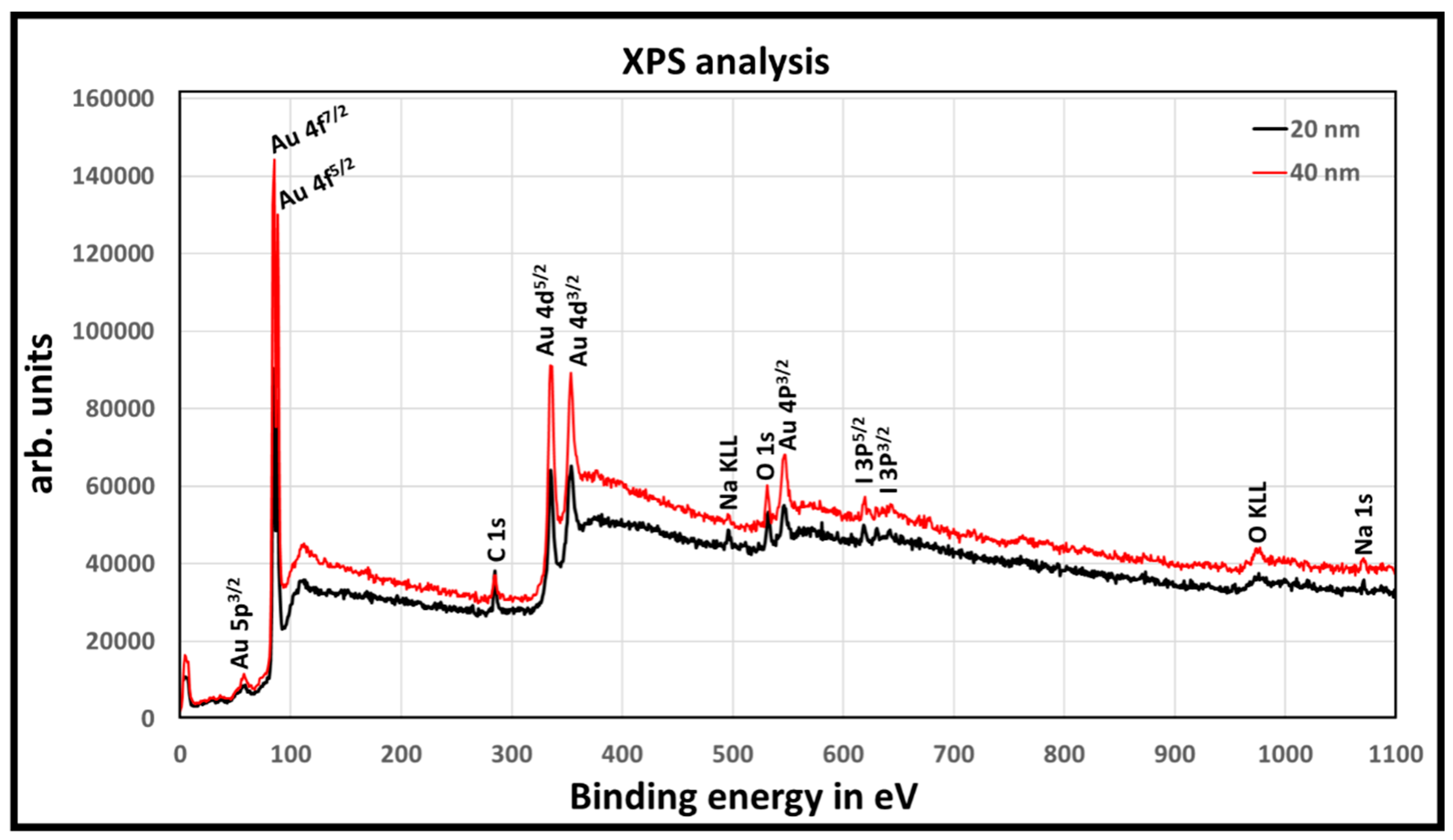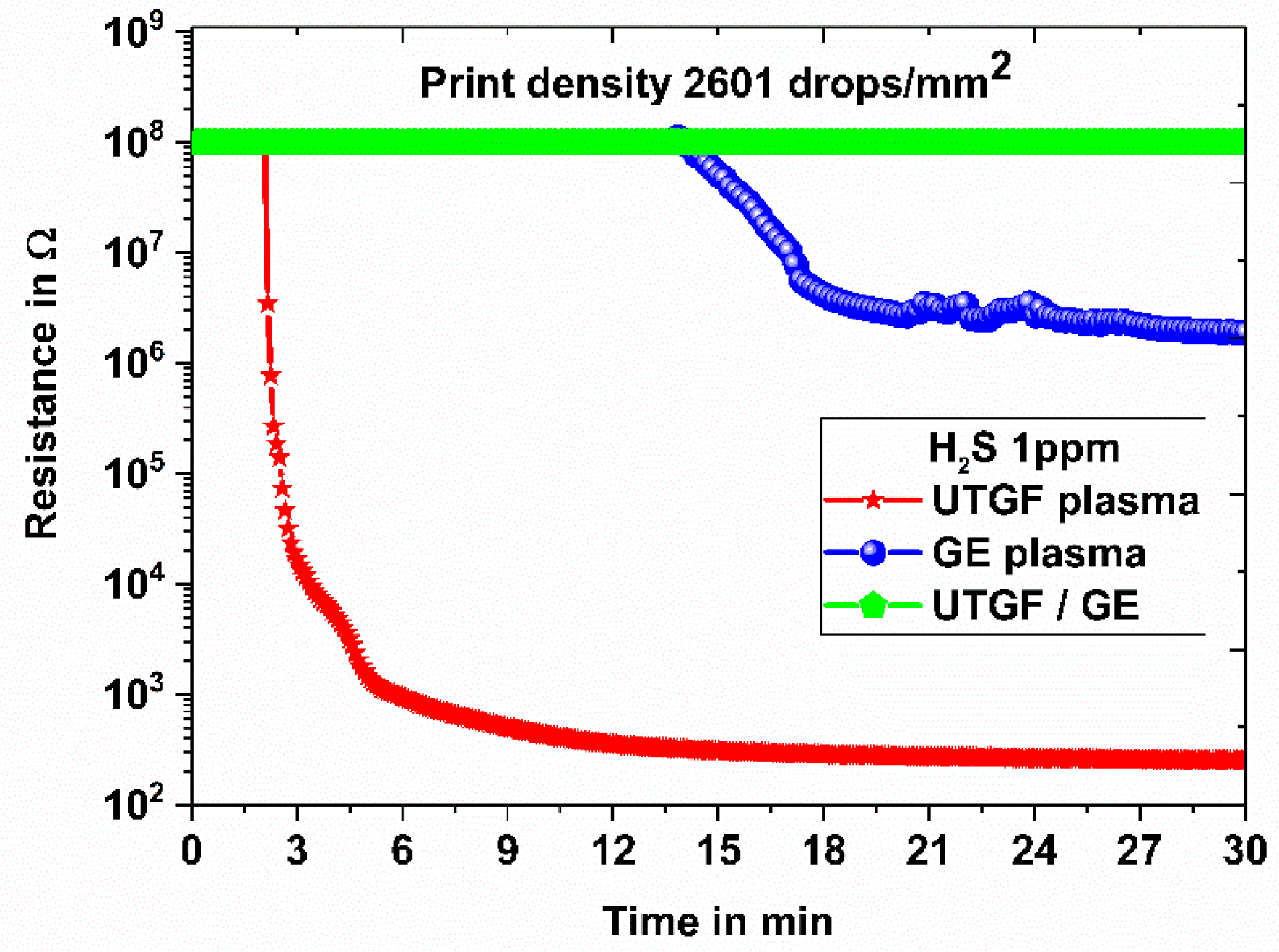Electro-Optical Gas Sensor Consisting of Nanostructured Paper Coating and an Ultrathin Sensing Element
Abstract
:1. Introduction
2. Materials and Methods
2.1. Paper Substrate
2.2. Latex-Coated Paper Substrate
2.3. Preparation of UTGF Electrodes
2.4. Inkjet Printing
2.5. H2S Sensing Experiments
2.6. X-ray Photoelectron Spectroscopy (XPS)
2.7. Atomic Force Microscopy
3. Results and Discussion
3.1. Chemiresistor Type H2S Sensor
3.2. Paper Strip Indicator for H2S
4. Conclusions
Supplementary Materials
Author Contributions
Funding
Acknowledgments
Conflicts of Interest
References
- Bollstrom, R. Paper for Printed Electronics and Functionality. Ph.D. Thesis, Åbo Akademi University, Åbo, Finland, 2013. [Google Scholar]
- Tobjörk, D.; Österbacka, R. Paper electronics. Adv. Mater. 2011, 23, 1935. [Google Scholar] [CrossRef] [PubMed]
- Apilux, A.; Dungchai, W.; Siangproh, W.; Praphairaksit, N.; Henry, C.S.; Chailapakul, O. Lab-on-paper with dual electrochemical/colorimetric detectionfor simultaneous determination of gold and iron. Anal. Chem. 2010, 82, 1727–1732. [Google Scholar] [CrossRef] [PubMed]
- Lüth, H. Solid Surfaces, Interfaces and Thin Films, 5th ed.; Springer: Berlin/Heidelberg, Germany, 2010. [Google Scholar]
- Ihalainen, P.; Määttänen, A.; Pesonen, M.; Sjöberg, P.; Sarfraz, J.; Österbacka, R.; Peltonen, J. Paper-supported nanostructured ultrathin gold film electrodes –Characterization and functionalization. Appl. Surf. Sci. 2015, 329, 321–329. [Google Scholar] [CrossRef]
- Rosolina, S.; Carpenter, T.; Xue, Z. Bismuth-based, disposable sensor for the detection of hydrogen sulfide gas. Anal. Chem. 2016, 88, 1553–1558. [Google Scholar] [CrossRef] [PubMed]
- Sarfraz, J.; Fogde, A.; Ihalainen, P.; Peltonen, J. The performance of inkjet-printed copper acetate-based hydrogen sulfide gas sensor on a flexible plastic substrate—Varying ink composition and print density. Appl. Surf. Sci. 2018, 445, 89–96. [Google Scholar] [CrossRef]
- Xu, H.; Wu, J.; Chen, C.; Zhang, L.; Yang, K. Detecting hydrogen sulfide by using transparent polymer with embedded CdSe/CdS quantum dots. Sens. Actuators B 2010, 143, 535–538. [Google Scholar] [CrossRef]
- Carpenter, T.S.; Rosolin, S.M.; Xu, Z. Quantitative, colorimetric paper probe for hydrogen sulfide gas. Sens. Actuators B Chem. 2017, 253, 846–851. [Google Scholar] [CrossRef]
- Virji, S.; Fowler, J.D.; Baker, C.O.; Huang, J.; Kaner, R.B.; Weiller, B.H. PANI nanofiber composites with metal salts: Chemical sensors for hydrogen sulfide. Small 2005, 1, 624–627. [Google Scholar] [CrossRef] [PubMed]
- Virji, S.; Kaner, R.; Weiller, B. Direct electrical measurement of the conversion of metal acetates to metal sulfides by hydrogen sulfide. Inorg. Chem. 2006, 45, 10467–10471. [Google Scholar] [CrossRef] [PubMed]
- Tekin, E.; Smith, P.; Schubert, U. Inkjet printing as a deposition and patterning tool for polymers and inorganic particles. Soft Matter 2008, 4, 703–713. [Google Scholar] [CrossRef]
- Li, J.; Sollami, S.; Zhang, P.; Yang, S.; Lohe, M.R.; Zhuang, X.; Feng, X.; Ostling, M. Scalable Fabrication and Integration of Graphene Microsupercapacitors through Full Inkjet Printing. ACS Nano 2017, 11, 8249–8256. [Google Scholar] [CrossRef] [PubMed]
- Jia, H.; Gao, H.; Mei, S.; Kneer, J.; Lin, X.; Ran, Q.; Wang, F.; Palzer, S.; Lu, Y. Cu2O@PNIPAM core–shell microgels as novel inkjet materials for the preparation of CuO hollow porous nanocubes gas sensing layers. J. Mater. Chem. C 2018, 6, 7249–7256. [Google Scholar] [CrossRef]
- Rieu, M.; Camara, M.; Tournier, G.; Viricelle, J.; Pijolat, C.; Rooij, N.F.; Briand, D. Fully inkjet-printed SnO2 gas sensor on plastic substrate. Sens. Actuators B 2016, 236, 1091–1097. [Google Scholar] [CrossRef]
- Bollström, R.; Tuominen, M.; Määttänen, A.; Peltonen, J.; Toivakka, M. Top layer coatability on barrier coatings. Prog. Org. Coat. 2012, 73, 26–32. [Google Scholar] [CrossRef]
- Juvonen, H.; Määttänen, A.; Ihalainen, P.; Viitala, T.; Sarfraz, J.; Peltonen, J. Enhanced protein adsorption and patterning on nanostructuredlatex-coated paper. Colloids Surf. B 2014, 118, 261–269. [Google Scholar] [CrossRef] [PubMed]
- Juvonen, H.; Määttänen, A.; Laurén, P.; Ihalainen, P.; Utti, A.; Yliperttula, M.; Peltonen, J. Printed paper-based reaction arrays for 2D cell cultures. Acta Biomater. 2013, 9, 6704. [Google Scholar] [CrossRef] [PubMed]
- Sarfraz, J.; Maattanen, A.; Torngren, B.; Pesonen, M.; Peltonen, J.; Ihalainen, P. Sub-ppm electrical detection of hydrogen sulfide gas at room temperature based on printed copper acetate–gold nanoparticle composite films. RSC Adv. 2015, 5, 13525–13529. [Google Scholar] [CrossRef]
- Zhou, X.; Xu, W.; Liu, G.; Panda, D.; Chen, P. Size-Dependent Catalytic Activity and Dynamics of Gold Nanoparticles at the Single-Molecule Level. J. Am. Chem. Soc. 2010, 132, 138–146. [Google Scholar] [CrossRef] [PubMed]







| 40 nm | Sample 1 at% | Sample 2 at% | Sample 3 at% | Average at% | Stdev |
|---|---|---|---|---|---|
| Au4f | 41 | 40.6 | 44.3 | 41.9 | 2.0 |
| C1s | 40.2 | 45 | 35.6 | 40.2 | 4.7 |
| O1s | 14.9 | 8.8 | 16.3 | 13.3 | 3.9 |
| I3d5 | 0.4 | 1 | 0.1 | 0.5 | 0.45 |
| Na1s | 3.5 | 4.6 | 3.9 | 4 | 0.5 |
| 20 nm | |||||
| Au4f | 22.6 | 34.6 | 24.6 | 27.2 | 6.4 |
| C1s | 43.8 | 55.9 | 60.4 | 53.3 | 8.5 |
| O1s | 27.3 | 9 | 13.1 | 16.4 | 9.6 |
| I3d5 | 1.4 | 0.6 | 1.1 | 1.0 | 0.4 |
| Na1s | 4.8 | 0.1 | 0.9 | 1.9 | 2.5 |
| Sample Name | Print Density in Drops/mm2 |
|---|---|
| 1 | 2028 |
| 2 | 4056 |
| 3 | 6084 |
| 4 | 8112 |
| 5 | 10140 |
| 6 | 12168 |
| 7 | 14196 |
| 8 | 16224 |
© 2019 by the authors. Licensee MDPI, Basel, Switzerland. This article is an open access article distributed under the terms and conditions of the Creative Commons Attribution (CC BY) license (http://creativecommons.org/licenses/by/4.0/).
Share and Cite
Sarfraz, J.; Rosqvist, E.; Ihalainen, P.; Peltonen, J. Electro-Optical Gas Sensor Consisting of Nanostructured Paper Coating and an Ultrathin Sensing Element. Chemosensors 2019, 7, 23. https://doi.org/10.3390/chemosensors7020023
Sarfraz J, Rosqvist E, Ihalainen P, Peltonen J. Electro-Optical Gas Sensor Consisting of Nanostructured Paper Coating and an Ultrathin Sensing Element. Chemosensors. 2019; 7(2):23. https://doi.org/10.3390/chemosensors7020023
Chicago/Turabian StyleSarfraz, Jawad, Emil Rosqvist, Petri Ihalainen, and Jouko Peltonen. 2019. "Electro-Optical Gas Sensor Consisting of Nanostructured Paper Coating and an Ultrathin Sensing Element" Chemosensors 7, no. 2: 23. https://doi.org/10.3390/chemosensors7020023
APA StyleSarfraz, J., Rosqvist, E., Ihalainen, P., & Peltonen, J. (2019). Electro-Optical Gas Sensor Consisting of Nanostructured Paper Coating and an Ultrathin Sensing Element. Chemosensors, 7(2), 23. https://doi.org/10.3390/chemosensors7020023




